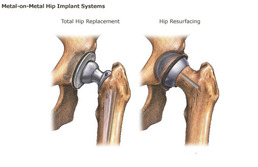
With the breakthroughs in technology, innovations are introduced and that includes metal-on-metal implants. Hip implants are among one of the pioneers in the field that can benefit those with severe hip problems especially the elderly. With hip deterioration, the need to find a prosthetic device for the diseased hip joints that could withstand the wear and tear overtime is on the rise. The goal is to make devices that can be permanent to avoid revision surgery hence saving time, money and effort. However, errors cannot be avoided like the issues the DePuy Pinnacle hip replacement system is facing. In fact, you may want to look at this DePuy Pinnacle hip replacement system report made by the Food and Drug Administration.
What is a Metal-on-metal Hip Device?
Metal-on-metal Hip Device is among one of the 4 device options currently available in the US for total hip replacement. The device is made up of metal with the ball, stem and shell as parts. Titanium and Cobalt-chrome are two most commonly used metals in metal-on-metal devices. There is no report on which metal is better but cobalt-chrome is known to be used for almost 65 years on orthopaedic devices with less reports of allergies and/or rejections. When it was first introduced in the US in 2002, it was considered as a huge breakthrough. Cobalt-chrome was the metal used in making the firstmetal-on-metal device.
Some companies like DePuy designed their metal-on-metal device to have an appeal on the youth and the active because of the durability.
Advantages of a Metal-on-metal Hip Device
Metal-on-metal devices are considered the most durable and can last for a long time if given proper care. Metal-on-metal device has a number of advantages such as the following:
Though it has benefits, the cons were also raised regarding metal-on-metal devices because some can do harm to the individual. Among the concerns raised is the development of metal toxicity as a result of metal particles wearing off due to friction upon movement. Over time, the metal particles can be a possible cause of injury to the bone and the tissues around and this phenomenon is called adverse local tissue reaction (ALTR). This phenomenon may be the cause of loosening of the implants which may need revision surgery. Such reports were made by individuals who filed a DePuy Pinnacle Lawsuit.
References:
www.accessdata.fda.gov/scripts/cdrh/cfdocs/cfMAUDE/detail.cfm?mdrfoi__id=1933948
www.accessdata.fda.gov/scripts/cdrh/cfdocs/cfMAUDE/detail.cfm?mdrfoi__id=1932627
www.accessdata.fda.gov/scripts/cdrh/cfdocs/cfMAUDE/detail.cfm?mdrfoi__id=1823546
www.fda.gov/MedicalDevices/ProductsandMedicalProcedures/ImplantsandProsthetics/MetalonMetalHipImplants/default.htm
www.hopkinsbayview.org/jointeffort/questionsabouthipreplacement.html
What is a Metal-on-metal Hip Device?
Metal-on-metal Hip Device is among one of the 4 device options currently available in the US for total hip replacement. The device is made up of metal with the ball, stem and shell as parts. Titanium and Cobalt-chrome are two most commonly used metals in metal-on-metal devices. There is no report on which metal is better but cobalt-chrome is known to be used for almost 65 years on orthopaedic devices with less reports of allergies and/or rejections. When it was first introduced in the US in 2002, it was considered as a huge breakthrough. Cobalt-chrome was the metal used in making the firstmetal-on-metal device.
Some companies like DePuy designed their metal-on-metal device to have an appeal on the youth and the active because of the durability.
Advantages of a Metal-on-metal Hip Device
Metal-on-metal devices are considered the most durable and can last for a long time if given proper care. Metal-on-metal device has a number of advantages such as the following:
- Greater freedom of activity
- Less chances of being dislocated
- Less total material removed (compared to other devices) when there is friction between the ball and socket
- Believed to last a relative longer period of time (at least 15 years) so a revision surgery or another hip replacement won’t be necessary
Though it has benefits, the cons were also raised regarding metal-on-metal devices because some can do harm to the individual. Among the concerns raised is the development of metal toxicity as a result of metal particles wearing off due to friction upon movement. Over time, the metal particles can be a possible cause of injury to the bone and the tissues around and this phenomenon is called adverse local tissue reaction (ALTR). This phenomenon may be the cause of loosening of the implants which may need revision surgery. Such reports were made by individuals who filed a DePuy Pinnacle Lawsuit.
References:
www.accessdata.fda.gov/scripts/cdrh/cfdocs/cfMAUDE/detail.cfm?mdrfoi__id=1933948
www.accessdata.fda.gov/scripts/cdrh/cfdocs/cfMAUDE/detail.cfm?mdrfoi__id=1932627
www.accessdata.fda.gov/scripts/cdrh/cfdocs/cfMAUDE/detail.cfm?mdrfoi__id=1823546
www.fda.gov/MedicalDevices/ProductsandMedicalProcedures/ImplantsandProsthetics/MetalonMetalHipImplants/default.htm
www.hopkinsbayview.org/jointeffort/questionsabouthipreplacement.html

 RSS Feed
RSS Feed